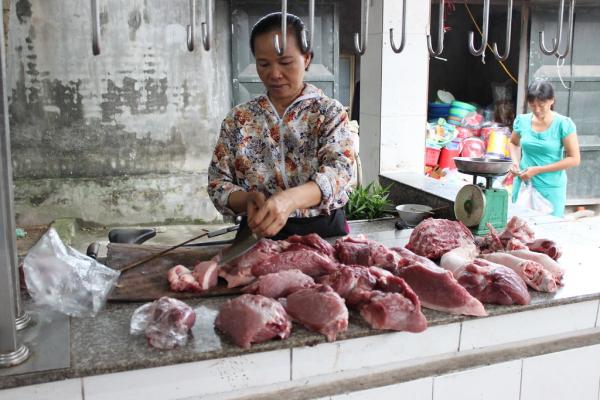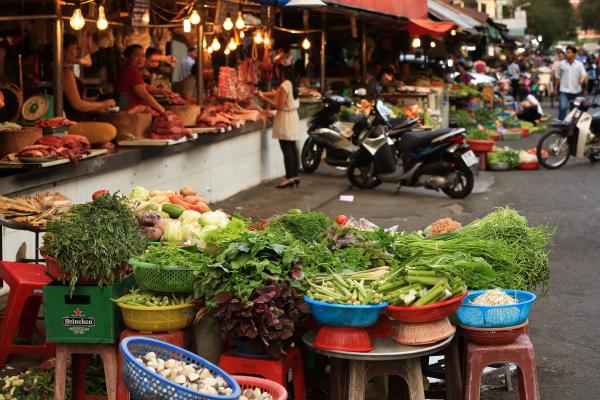



Wet markets – close down or keep?
In the fallout of the COVID-19 wet markets are under intense scrutinyIn advanced economies, traditional markets have been increasingly replaced by large supermarkets with fresh food and animal products wrapped in plastic packaging. For many low and middle-income countries however, traditional markets are still the predominate food-source for billions of people, particularly those living below the poverty line, writes the Australian Centre for International Agricultural Research (ACIAR).
In the fallout of the COVID-19 pandemic, these informal marketplaces—particularly in Asia—have come under intense scrutiny, with initial speculation that a ‘wet’ market in Wuhan, China, was ground-zero for the coronavirus outbreak.
While demands for wet markets to be closed are perhaps understandable, it is important to consider that this is the primary food-source for billions of people. Any calls for a shutdown should recognise the many and varied functions of wet markets, along with understanding the critical role farmers and vendors play in avoiding similar outbreaks in the future.
The Australian Centre for International Agricultural Research (ACIAR) has been supporting scientific research into zoonotic disease and food safety in our agri-food systems, including wet markets, for over 10 years. Through funding to CGIAR research centres, such as the International Livestock Research Institute (ILRI) and International Food Policy Research Institute (IFPRI), ACIAR has partnered on research that is helping to understand how human and animal health interact in these environments and to develop methods to reduce the risk of food-borne diseases, familiar and novel.
What are wet markets?
Markets have existed for millennia but the term “Wet market” came to prominence during the 19th century in Asia to describe open or semi-open markets, with small individually-owned stalls, where vendors sold fruit, vegetables and livestock and fish products and using water to keep their produce fresh and clean. The term ‘wet market’ was contrasted with dry markets, which traded in goods like cereal and grain.
Today, ‘wet market’ is a broader term often used to lump together various ‘traditional’, ‘local’ or ‘informal’ markets, each with varying food safety practises.
‘The etymology is interesting but confusing’, says Dr Delia Randolph, ILRI’s Program Leader in Animal and Human Health. ‘Not all wet markets are alike. They can be open-air spaces where hawkers spread their fruit and vegetable wares on the ground, or covered buildings with electricity and refrigeration. Most sell fresh meat, live fish and live or dead poultry,’ she says. ‘There’s a huge spectrum of products and risks.’

Dr Randolph has been leading an ACIAR-funded project in Vietnam, together with her Hanoi-based colleague, Dr Hung Nguyen, focusing on the sale of pork in these market environments. Pork is the most popular meat in Vietnam, with the majority produced by smallholder farmers and sold fresh in traditional markets. In a country where childhood stunting is still common, animal-sourced foods are an important contributor to healthy diets.
Dr Nguyen says the farmers offer the fresh, natural food that their customers want at affordable prices, which has helped underpin stable food security in the region for a long time.
"They are cultural and tourist assets and support the livelihoods of millions, many of them women," he adds "These wet markets also provide essential sources of fresh meat and other perishable goods for people who lack access to refrigeration."
What is the risk in wet markets?
Dr Anna Okello, ACIAR’s Livestock Systems Research Program Manager, has been working in the veterinary public health space for more than 15 years and understands better than most the risks that wet markets can pose, however makes an important distinction between quantified risk, and the “perception” of risk.
"There are certainly diseases that can spill over from animals into humans, and a key objective of ACIAR-funded projects in the area of food safety is to focus on identifying how high that risk actually is," Dr Okello says. "Wet markets have no packaging and the goods usually come without certifications or stamps to indicate that they comply with national food safety standards. As a result, people who are used to the regulations of supermarkets and other formal market chains tend to see wet markets as unsafe."
But realistically, the opposite could be true.
"It’s a myth that one is safe, and one is not," Dr Randolph says. "It’s about how things are managed. We need to gradually upgrade wet markets to maximise the benefits while minimising the risks."
Dr Randolph and Dr Okello, who have worked together on the ACIAR-funded Safe Pork project led by ILRI in Vietnam, talk about how the interactions between people and animals can pose problems.
According to Dr Randolph, ‘antimicrobial resistance, foodborne diseases and poor animal health’ compromise food safety. One of the ILRI program’s objectives is to build resilience to risk among smallholder farmers and the communities that rely on the food they produce.
Dr Okello describes wet markets as beneficial for those who rely on them as well as good for the health of the planet. She appreciates the fact that wet markets are sustainable and limit waste. "They’re environmentally friendly with less packaging and transport costs," she adds. "In most of the countries where ACIAR works, it’s not an option to take away informal markets."
Both Dr Okello and Dr Randolph point out that wet markets are not exclusive to Asia or the world’s developing countries. "We have ‘wet’ markets here in Australia," Dr Okello says.
In a similar vein, Dr Randolph suggests that many of the markets in Vietnam are "as safe and clean" as our local farmers’ markets. She stresses that the wet markets in the South-East Asian country are often hygienic and they are managed well, with municipal authorities checking on the conditions.
Research in food safety have shown that the likelihood of foodborne disease increases with the length of value chains.
"The bigger the distance between producers and consumers, the greater the risk," says Dr Nguyen. "In the wet market situation, value chains are relatively short, with the food moving quickly to prevent it spoiling."

He adds that in the case of Vietnam, pigs are slaughtered in the early hours of the morning, sold by breakfast time and often in the pot by midday with leftovers eaten at night, leaving little time for contamination to occur.
Compare this to local supermarkets and other modern outlets where meat is packaged under plastic in cellophane and shop workers in uniforms serve their customers. While everything looks hygienic, electricity may go off once or twice a day and the longer value chains mean products can sit on the shelves for longer than is ideal.
The varying factors in determining the risk of wet markets further underlines the need to take a holistic approach to fully understand the issues around food safety and zoonotic disease control.
"We will never have health security without food security. We will never have good food security if we don’t have optimal health of the environment in which we are living, working and producing that food," says Dr Okello.
Recently appointed as a Lancet Commissioner for One Health, Dr Okello is adamant that looking at the larger One Health picture will ultimately help us understand, manage and prevent future disease spill over events.
Understanding and managing risk
"We’re not denying the risks or that disease could have emerged from a wet market scenario," says Dr Okello. Instead, she argues for ongoing assessment of the risks to food safety, with research-based evidence to quantify the claims.
"It’s not just the human health sector that’s involved in lots of countries," she explains. "We need to look at the upstream drivers." Many factors influence human, animal and environmental health and increase the likelihood of pandemics. Dr Okello lists building roads through forests, eating differently and the spread of urbanisation as major factors.
"In many ways we’re in closer contact with the wildlife species that are the natural reservoirs of some human diseases," she says.
Dr John McDermott emphasises that upgrading the safety of wet markets involves helping those who use them to understand the risks. He is director of the CGIAR Research Program on Agriculture for Nutrition and Health (A4NH) at IFPRI, which leads the program that funds much of ILRI’s work on informal markets.
"People have been rightly concerned about new viruses for some time," he says, agreeing with Dr Okello that contacts with wildlife and forests increase the chances of disease emergence. Domestic animals can also act as a bridge between wildlife – the source of most novel human infections – and humans. He urges working with people involved in bushmeat trade and cautions that outlawing this will drive people desperate for income underground.
"This would make the risk worse," he argues. "It is better to work with bushmeat traders to track and manage the risk better."
Dr Randolph heads up the A4NH flagship program on food safety, which conducts targeted research to find solutions that suit informal and formalising markets. The focus falls on managing food safety risks while aligning public health goals with each country’s priorities.
The impact of research locally and globally
According to Dr Okello, "everything is connected." She applauds the links between human and veterinary disciplines as they coexist and inform each other, especially on zoonotic diseases. Likewise, Dr McDermott stresses the value of researchers working together to reshape food systems in response to COVID-19. He wants to see ‘open information sharing in a timely manner.’
Dr Randolph regards ‘collaborative efforts’ as the way to manage food safety in developing countries. She notes that both the Pig Risk and Safe Pork projects in Vietnam, funded by ACIAR, were developed in the One Health paradigm. As an example of how experts benefit from pooling their knowledge and resources, Dr Randolph cites the regional symposium on research into smallholder pig production, health, and food safety. The event, which was held in Hanoi in March 2019, helped to build international networks on pig research.
Just as viruses can spread between species, pandemics and crises call for global partnerships. It is near impossible for individual sectors and disciplines to address health issues alone, especially when they occur at the human–animal–environment interface. Dr Okello proposes "a more joined-up approach."
From their respective bases in Nairobi, Hanoi, Washington D.C and Canberra, they are all united in creating broader global perspectives. Their leading research covers everything from the transformation of wet markets to the promise of a food-secure future.






